Dietary Sugar Statistics By Country, Age, Type and Gender

Page Contents
Introduction
Dietary Sugar Statistics: Dietary sugar consumption has long been recognized for its potential negative impact on health. Recent studies indicate that many nations' average added sugar intake exceeds recommended levels. According to one estimate, Americans consume an estimated 17 teaspoons of added sugar per day or 57 pounds annually in America alone – figures which mirror an increasing global trend of increasing added sugar intake.
Obesity, type 2 diabetes, cardiovascular disorders, and dental difficulties have all been linked with excessive sugar intake. The World Health Organization (WHO) recommends keeping added sugar intake to no more than 10% of total daily caloric intake; greater health advantages can be realized by keeping it to less than 5%. Recent statistics reveal that many individuals, particularly children, and teenagers, exceed these guidelines by an enormous margin. High consumption rates are due to an abundance of processed meals with excessive levels of sugar as well as effective marketing campaigns targeting these items. To encourage healthy eating habits and raise public awareness of the hazards associated with excessive sugar intake, various public health initiatives, educational campaigns, and regulatory measures have been put in place.
Editor's Choice
- Every day, Americans consume 99 grams or 17 teaspoons of sugar; the American Heart Association suggests no more than 45 grams for men and 30 for women respectively.
- Numerous studies have established a connection between sugar consumption and obesity through both clinical trials and molecular chemistry studies.
- A 34-year study found that drinking two sugary beverages each day doubles your risk of cancer and cardiovascular disease death.
- Globally, we use approximately 165 million tons of sugar annually – that translates to 23 kilograms per person on average!
- Children consume increasingly sweet treats as they age; those between 12-19 consume two times as much sugar as younger children do.
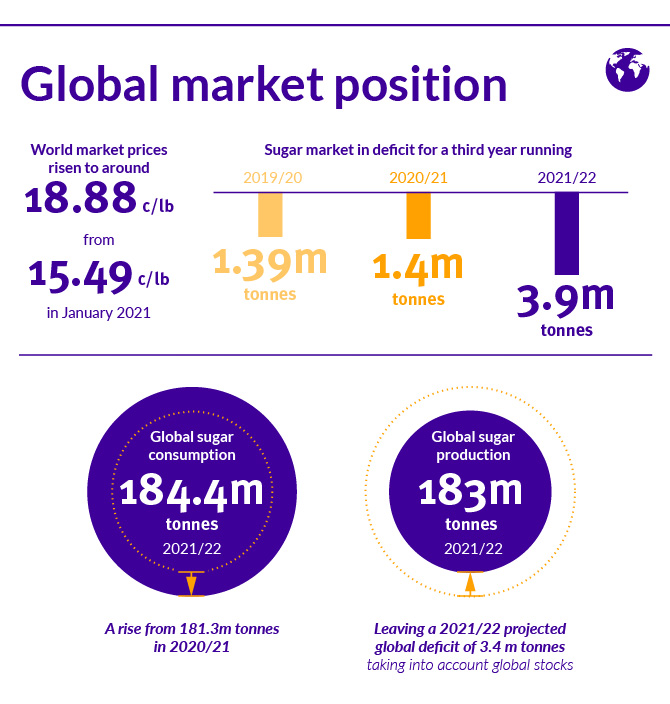
(Source: ragus.co.uk)
General Dietary Sugar Statistics
Dietary sugar data reveal how much sugar is consumed and its impact on people's health. With links to obesity, type 2 diabetes, cardiovascular illnesses, and dental difficulties attributed to excessive sugar intake – particularly added sugars – it has attracted considerable public interest.
- Over the last several decades, sugar consumption has steadily risen worldwide. According to FAO data, the average annual per-person sugar consumption worldwide has increased from 30 pounds in the 1960s to over 53 pounds today.
- Additives that are added during manufacturing, preparation, or serving of foods and beverages are known as “added sugars.” Their consumption varies widely by country; Americans on average consume around 57 pounds annually or 17 teaspoons daily of added sugars.
- The World Health Organization (WHO) recommends capping added sugar consumption at no more than 10% of daily caloric intake; 5% or lower may even provide further health advantages. Many nations have implemented these recommendations in order to promote healthier eating habits.
- A 34-year study found that drinking two sugary beverages each day doubles your risk of cancer and cardiovascular disease death.
- Globally, we use approximately 165 million tons of sugar annually – that translates to 23 kilograms per person on average.
- Children and teenagers are at greater risk of eating too much sugar than ever. According to data from the National Health and Nutrition Examination Survey (NHANES), US children and teenagers consume 16% of their daily calories from added sugars, placing their health in jeopardy as this amount exceeds recommended limits by far.
- Sugary beverages (SSBs), including soft drinks, energy drinks, and fruit juices with added sugars, are among the primary contributors to increased sugar intake in the United States. According to research published in Circulation Journal, 39% of added sugars consumed by Americans come via these beverages.
- Obesity and excessive sugar intake are intimately connected; with rising consumption comes increased prevalence. According to research published in the British Medical Journal (BMJ), the risk for obesity increased by 60% per additional sugar-sweetened beverage consumed every day.
- Dental caries (tooth decay) are strongly affected by high sugar intake. According to the World Dental Federation (FDI), high-sugar diets are the primary culprits behind dental cavities that affect 60-90% of students and nearly 100% of adults worldwide.
- Public health programs and legislative changes around the globe are being undertaken to curb excessive sugar intake, including enacting sugar taxes, improving food labeling to emphasize added sugar levels, restricting children's exposure to advertisements for sugary goods, and encouraging instruction on healthy eating practices.
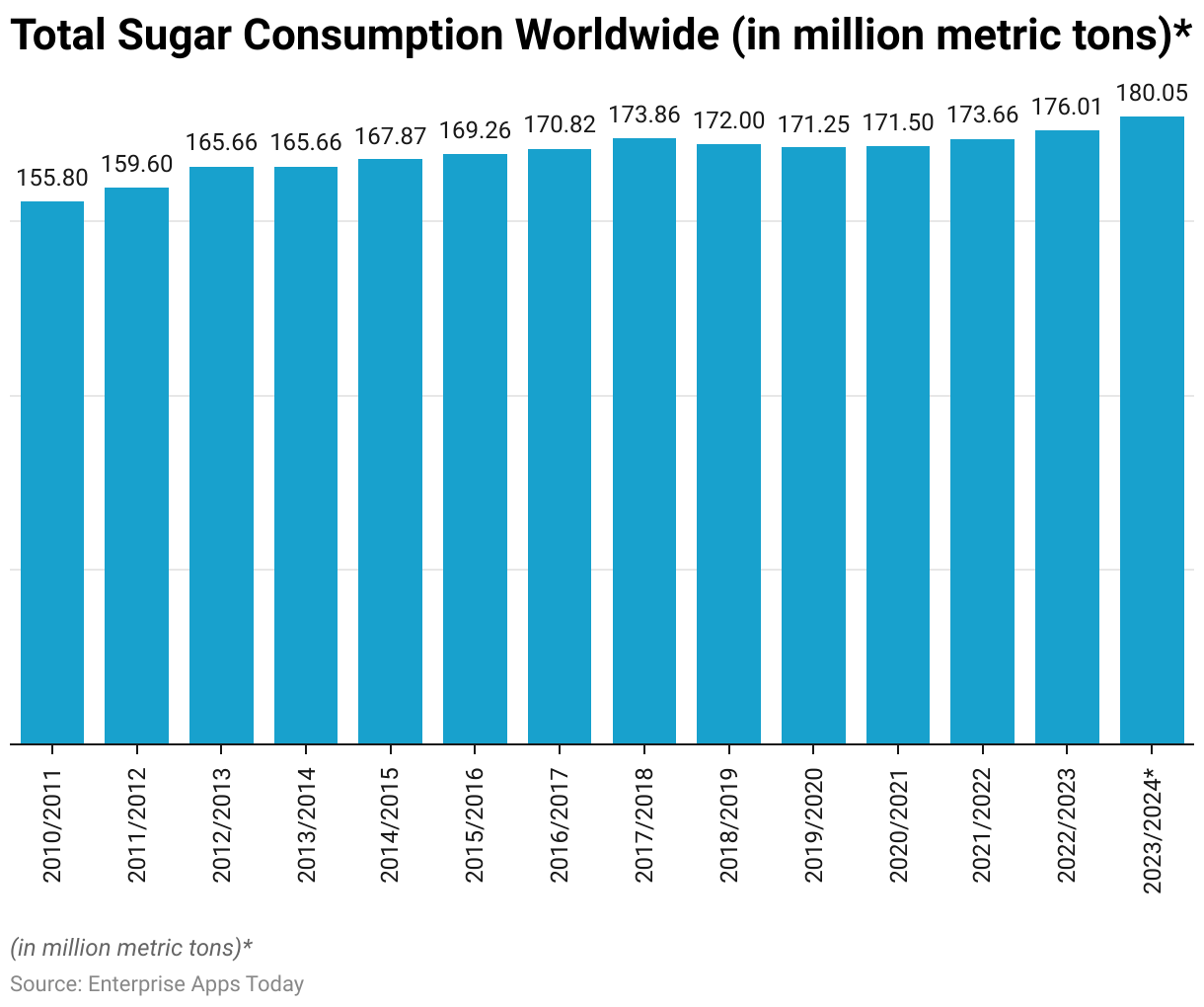
(Source: statista.com)
Dietary Sugar Statistics By Type
By distinguishing added sugars from natural ones, dietary sugar data may be examined more comprehensively. Foods like fruits and dairy contain natural sugars while added sugars may be added during processing, preparation, or serving processes.
- Sweetened beverages, desserts, snacks, and sauces contain added sugars in many forms, and their average consumption varies by nation. American adults consume an excess of added sugars than is recommended – approximately 77 grams (19 teaspoons daily according to the American Heart Association.
- Soft drinks, energy drinks, and sweetened teas are examples of sweetened beverages (SSBs) with added sugars that contribute to excessive consumption, especially among children and teenagers. According to studies conducted worldwide, beverages containing added sugar comprise an increasingly significant share of added sugar consumption: 39% in the US for instance!
- Foods processed using chemicals such as cereals, cookies, cakes, and candies often contain excessive levels of added sugars. Granola bars and flavored yogurts may also contain hidden sources of sweeteners that could increase an individual's sugar consumption to an unhealthy level if taken without caution.
- Fruit juices contain high sugar levels despite being made of fruit. Juicing processes remove much of the fiber found in whole fruits, leading to higher concentrations of sugar levels even though these drinks may include vitamins and minerals. It is best to consume whole fruits instead of fruit drinks for optimal benefits of fiber while cutting back on unnecessary calories.
- Sugars are naturally present in fruits and dairy products, providing important vitamins, minerals, and fiber. Therefore it is wise to include natural sugars as part of a balanced diet in moderation.
- Unexpected items, like condiments, salad dressings, and salty snacks may contain hidden sources of added sugars that increase overall consumption without people even realizing it. It may be easier to locate such sources if you read product labels closely and familiarize yourself with their various names (corn syrup, high fructose corn syrup, and maltose being among them).
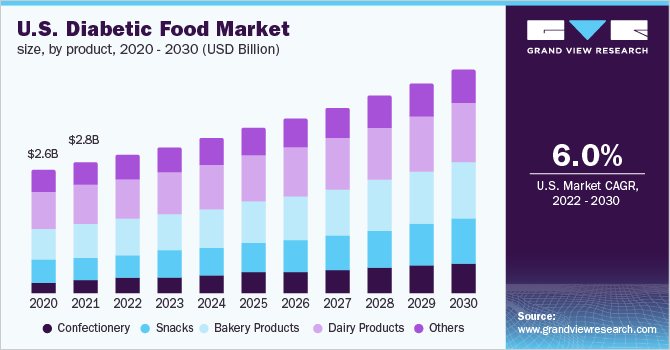
(Source: grandviewresearch.com)
Dietary Sugar Statistics By Country
Due to differing dietary behaviors, cultural norms, and food access issues between nations, dietary sugar data varies considerably between nations.
- United States adults consume one of the highest average sugar intake rates worldwide. American Heart Association research estimates that on average an American adult consumes more added sugar than is recommended, approximately 77 grams (19 teaspoons). Main sources include beverages containing added sugars, sweets crafted with grains, and snacks.
- Sugar consumption among American citizens is one of the highest ever.
- Studies indicate that 40% of an average American's daily caloric consumption comes from empty calories from added sugars and fats.
- Mexico stands out as being among the countries with one of the highest sugar consumption rates. According to estimates by Mexico's National Institute of Public Health, Mexicans consume approximately 365 calories of added sugar every day – or 22 teaspoons! – through traditional sweetened treats, processed meals, and sugary beverages – significantly increasing daily total.
- Brazil is widely recognized for having an excessive sugar-beverage consumption rate, according to research published in PLOS ONE. Brazilians consume an estimated average of 132 caloric equivalents each day from sugary drinks – 17% of their daily caloric intake! Unfortunately, such excessive consumption contributes significantly to public health concerns and obesity-related illness risk factors.
- Sugar consumption in the UK has attracted widespread scrutiny. Adults in this country on average consume more added sugar than is recommended – an estimated average daily dose of 58 grams or 14 teaspoons according to the National Diet and Nutrition Survey. Beverages with added sugar, baked goods, and candy all significantly contribute to our sugar intake.
- Australians consume far more sugar than what is recommended by experts, according to data provided by the Australian Bureau of Statistics. Individuals typically consume an estimated daily average of 60 grams (15 teaspoons). One of the primary sources of added sugars in Australia's diet is sugary drinks followed by baked goods like cakes and biscuits as well as cereals for breakfast.
- Research published by the Journal of Nutritional Science and Vitaminology indicates that Japan consumes less sugar compared to some other nations. Individuals consume on average 50 grams (12 teaspoons) daily of sugar, according to these findings. This may be attributed to Japan's traditional diet consisting of fresh fish, vegetables, and fermented products which reduce sugar intake.
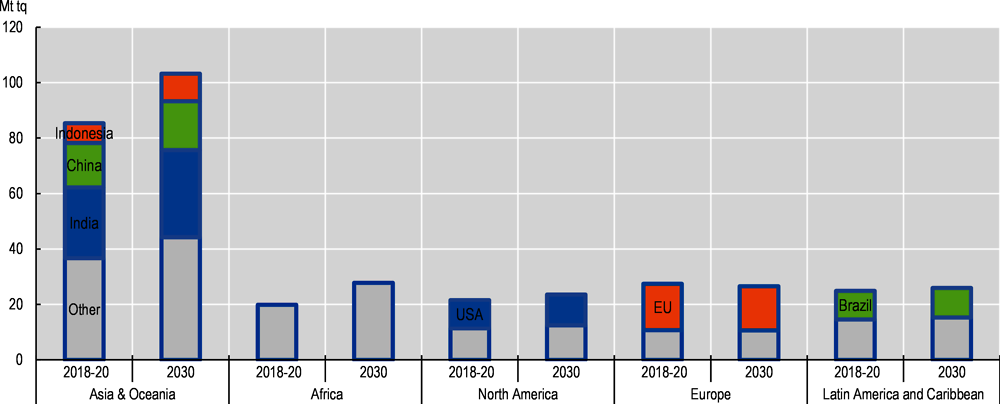
(Source: OECD-ilibrary.org)
Dietary Sugar Statistics By Age
Different age groups tend to consume dietary sugar differently, with certain age groups showing more or less than average consumption of this sweet substance.
- Baby formula or breast milk which includes naturally-occurring carbohydrates is typically adequate to provide sustenance to infants, and sugar dependency should be avoided when transitioning to solid meals. According to the American Heart Association, children under two should not consume added sugars; however, research revealed that 60% of babies and toddlers in the US consumed added sugars through sweetened snacks such as flavored yogurts or sweetened treats containing added sugars.
- Children consume increasingly sweet treats as they age; those between 12-19 consume two times as much sugar as younger children do.
- Children and teenagers are particularly at risk of consuming too much added sugar. According to the National Health and Nutrition Examination Survey (NHANES), approximately 16% of their daily calorie consumption comes from added sugars; their consumption often comes in the form of processed snacks, sweets, desserts, beverages with added sugars, or beverages with sugar added directly.
- Adults continue to consume too much-added sugar; on average; an American adult exceeds daily guidelines by approximately 77 grams (19 teaspoons). Sweetened drinks, desserts, snacks, and processed meals often contain added sugars.
- Sugar consumption by older individuals varies based on individual diet preferences and can differ according to health management goals. Some may choose to follow nutritional guidelines and limit added sugar, while others may consume more due to individual tastes or lack of knowledge. To improve health management efforts, older persons with chronic diseases such as diabetes or cardiovascular disease may be encouraged to reduce their sugar consumption further.
- Senior citizens may consume less sugar due to shifting taste preferences, dental health issues, or medical ailments; however, hidden sources of sugar remain in processed food and drinks consumed by this age group, necessitating personalized dietary advice tailored specifically for their condition.
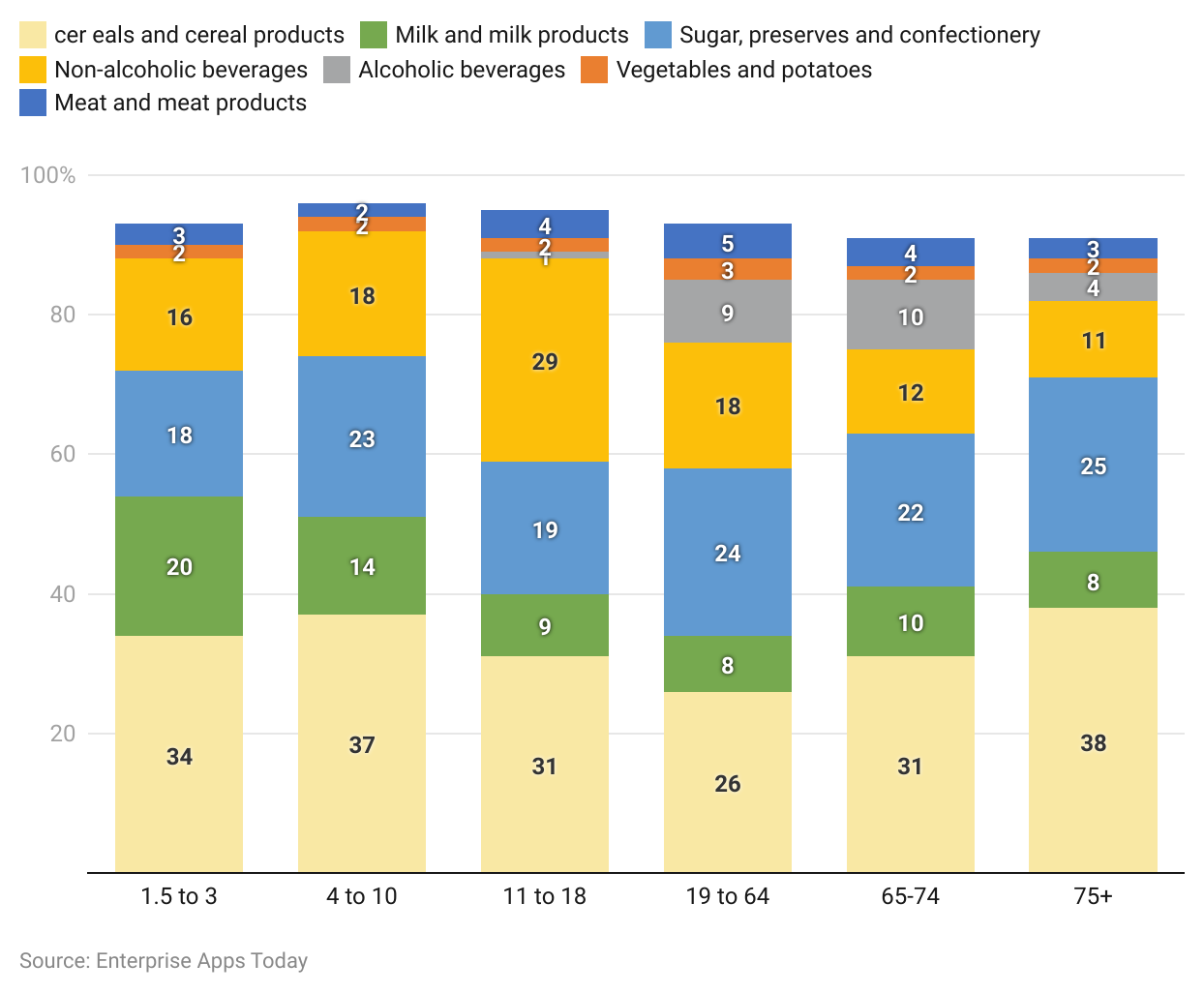
(Source: nutrition.org.uk)
Dietary Sugar Statistics By Gender
Due to gender-specific differences in food preferences and eating patterns, sugar consumption could vary between men and women. Gender-specific data may fail to show meaningful variance.
- There is limited evidence suggesting a difference in sugar consumption between men and women, though both sexes can consume an abundance of sweet beverages, desserts, and processed meals that contain added sugars.
- According to studies, both men and women consume more added sugar than is recommended; the average daily added sugar consumption in the US for both genders averages out at around 77 grams (19 teaspoons).
- Consumption of sugar-loaded beverages such as soft drinks, energy drinks, and sweetened teas can contribute to an increase in total daily sugar intake for both men and women alike. Both sexes may consume these drinks that provide additional calories through added sugars in their diets.
- The American Heart Association suggests no more than 45 grams for men and 30 for women respectively.
- Girls consume on average 15.5% of their caloric intake through added sugars compared to 16.3% for boys.
- Children and adolescents of non-Hispanic white origin consume more calories from added sugars than their Mexican-American counterparts.
- Individual dietary tastes and decisions can have an effect on one's sugar consumption, even though there may not be significant variations between genders in terms of overall intake. Research shows, for instance, that women tend to favor sweeter meals and beverages than men do – it's important to remember though that variation between people will differ greatly and this doesn't apply universally.
- Dietary restrictions such as restricting sugar intake may be needed to address gender-specific health conditions like gestational diabetes in women. Just like diseases such as type 2 diabetes or cardiovascular disease can impact both sexes equally, sugar consumption must also be carefully managed and controlled.
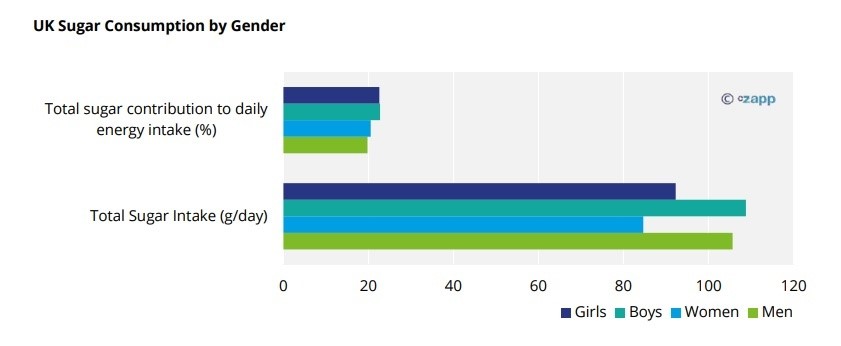
(Source: chinimandi.com)
Sugar Intake Statistics
Statistics on dietary sugar intake shed light on trends and consumption levels among various populations.
- Sugar consumption varies drastically by location. According to estimates by the Food and Agriculture Organization (FAO), in 2022 each individual consumed an estimated annual average of 24 kilograms (53 pounds) of sugar; however, individual or national sugar intake can differ dramatically between nations or even within nations themselves.
- Overindulgence in sugar consumption is a serious health threat. According to the World Health Organization (WHO), free sugars (which include both naturally occurring and added sugars) should not account for more than 10 percent of a person's total caloric intake each day – this advice applies to both adults and children. Many populations go beyond this recommendation – research conducted in Nutrients revealed that many European nations consumed more sugar than recommended, with average consumption ranging between 13.8%-21.22% of total calorie intake respectively.
- Carbonated soft drinks contain 10 teaspoons of sugar, yet even though more than 60% of Americans deliberately avoid carbonated drinks, an average person will still drink 53 gallons of soda annually.
- According to the American diet, an average American consumes 500 extra calories daily due to their increased sugar consumption.
- An excessive sugar intake is linked with up to 40% of US healthcare costs.
- Compared to adults, children often consume more sugar. According to a systematic review and meta-analysis published in Nutrients Journal, children between 2-18 worldwide consumed an excessive amount of added sugar – an average of 78 grams (19 teaspoons). Sugar was most commonly found in drinks with added sugar; candy, desserts, and processed snacks as major sources.
- Sugar consumption patterns could be affected by socioeconomic factors. According to studies, those from lower socioeconomic positions tend to consume more sugar. One such study revealed that American households with lower incomes consumed more added sugars than homes with higher incomes – according to data published by the American Journal of Clinical Nutrition.
- Drinks containing added sugars make up a substantial part of many diets. According to estimates by the Global Burden of Diseases, Injuries, and Risk Factors Study (GBD), in 2022 they will serve as the main source of sugar consumption among both adults and children globally; comprising 39% for kids and 30% for adults respectively.
- Sugar intake often goes undetected due to hidden sources like packaged snacks, sauces, and processed meals. According to the American Heart Association, 74% of packaged goods found in supermarkets contain added sugars which makes it hard for individuals to detect and limit their sugar consumption.
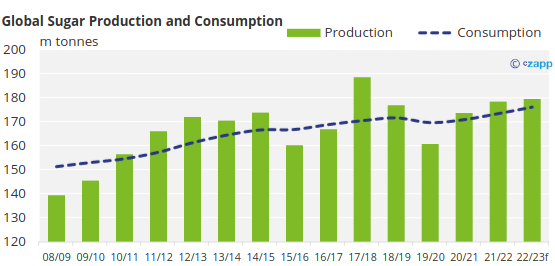
(Source: czapp.com)
Excess Dietary Sugar Statistics
Studies demonstrate the negative repercussions of excessive sugar consumption and its adverse impacts on health.
- Obesity and excessive sugar intake are closely connected. According to the World Health Organization (WHO), obesity has nearly quadrupled since 1975; according to NHANES data collected between 2021-2022 in the US alone, 42.4% were considered obese individuals.
- Consuming sugar significantly increases your chances of type 2 diabetes. According to estimates by the International Diabetes Federation, 463 million adult diabetics were estimated worldwide as of 2022 and this number will grow rapidly to 700 million by 2045 – an increase in prevalence which many believe can be tied to diet choices like too much sugar intake.
- An increase in cardiovascular disorders such as heart disease and stroke are linked to diets high in sugar. According to the American Heart Association, cardiovascular illnesses will remain the number one killer in 2022 with 859,125 deaths expected due to cardiovascular illness alone.
- Sugar consumption is one of the primary contributors to dental problems. According to World Health Organization data, between 60-90% of children worldwide had dental caries by age three; and according to Global Burden of Disease Study, 2022 data, close to 3.5 billion people globally suffered from oral disorders.
- Non-Alcoholic Fatty Liver Disease is associated with excessive sugar intake, particularly fructose. According to the Global Burden of Disease Study 2022, 24% of the world's population would have had NAFLD during that year.
- Studies suggest there may be an association between high-sugar diets and mental health problems and an increased incidence of anxiety and sadness; according to one published in Scientific Reports. Eating more added sugars was linked with more cases.
- According to the National Health and Nutrition Examination Survey; in 2022 over two-thirds of American adults were overweight while one out of thirteen were considered obese.
- Studies show that teenagers who are overweight have an estimated 70 percent risk of becoming obese or overweight adults as adults.
- Craving too much sugar may lead to insufficient levels of chromium.
- Studies have established links between excessive sugar intake and an increased risk of various cancer types such as breast; colorectal and pancreatic cancer; yet its exact relationship is yet to be studied in depth.
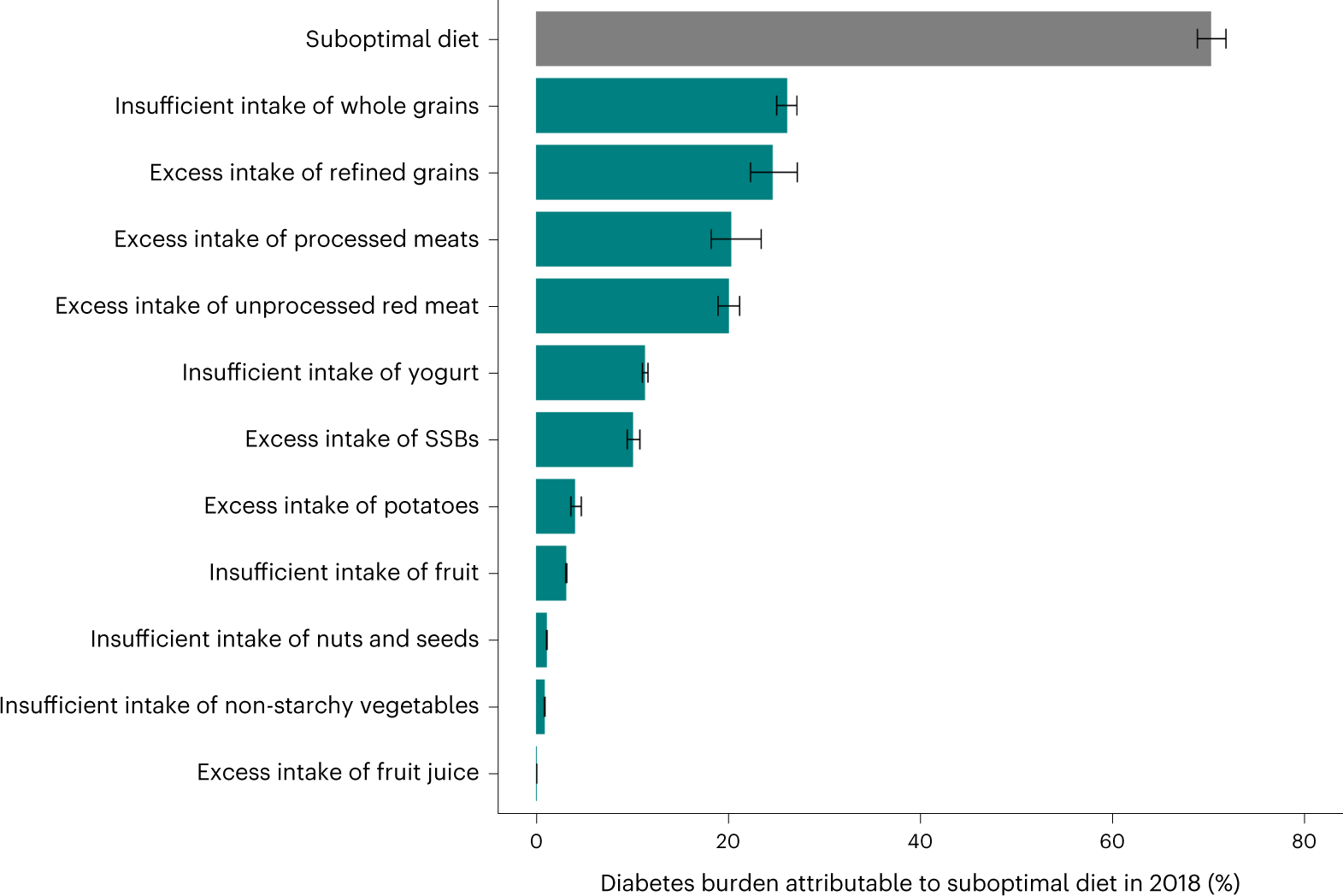
(Source: nature.com)
Impact on the Economy
Numerous figures that demonstrate the financial repercussions of excessive sugar consumption highlight its negative impact on the economy.
- Diet-related disorders associated with sugar intake carry an enormous economic burden. According to research published in the Journal of Health Economics, treatment costs associated with obesity-related medical conditions alone in the US totaled an estimated annual cost of $190 billion – with type 2 diabetes and cardiovascular illnesses contributing significantly towards these expenses.
- Poor eating habits, like consuming too much sugar, could reduce worker productivity. According to the American Diabetes Association, diabetes will cost the US economy $327 billion by 2022 in terms of both direct medical expenses and indirect costs such as lost productivity or incapacity.
- Food and beverage businesses' reliance on sugary goods has had financial repercussions. Customer preferences have changed due to greater public awareness about health risks linked to sugar use; Euromonitor International reports that between 2020-2022 sales of carbonated soft drinks containing added sugars declined globally by one percent; reflecting consumer preferences as well as impacting industry profits.
- The agriculture industry and international trade are heavily impacted by sugar production and trade. Sugar exports provide Brazil, one of the world's major producers, with significant revenue sources. But nations producing sugar may face unexpected changes when commodity price fluctuations impact profitability or consumer preferences shift towards products with reduced sugar.
- Countries have adopted sugar-related taxes, such as those on beverages with added sugar, to both reduce consumption and raise money. Mexico was an early adopter, where their implementation resulted in a 12% reduction of sales of beverages subject to this tax, leading to an increase in tax income for their government.
- Sugary product marketing and advertising; contribute to the economy by; creating jobs in the advertising sector and spending money on advertisements while raising concerns regarding the aggressive targeting of children as consumers. According to one study by Rudd Center for Food Policy and Obesity; food and beverage companies sold sugary items to children for an estimated total of $1.8 billion in advertising spend between 2022-2025 in the US alone!
Trends and Predictions
Trends and forecasts on diet sugar consumption provide key insight into how patterns of consumption are shifting and can assist in anticipating possible opportunities and issues in the future.
- Consumers are becoming more and more cognizant of the risks that excessive sugar intake poses to their health, with more seeking information and taking steps to limit their sugar consumption as a result. Accessibility of health-related content on the internet and social media, as well as educational initiatives conducted by health groups, is driving this trend.
- Governments, health groups, and food producers are taking measures to curb sugar consumption. Many nations have instituted sugar levies on sweetened beverages and foods or are considering the implementation of similar taxes; food manufacturers are offering sugar-free options or reformulating items to contain less sugar – all designed to shift consumer preferences towards lower-sugar foods while encouraging healthy eating practices.
- Alternatives that are low in sugar and sugar-free are becoming increasingly popular with customers who seek sweet-tasting goods without high sugar content. Due to this trend, more low-sugar and sugar-free items, including drinks, snacks, and sweets have become readily available on store shelves.
- Artificial and natural sweeteners such as aspartame and sucralose as well as natural ones like stevia and monk fruit extract have grown increasingly popular as customers search for alternatives to conventional sugar. Such sweeteners have seen particular success when advertised as “sugar-free” or “diet” options because they provide sweet flavor while offering no or minimal calories.
- Although efforts have been undertaken to limit sugar in visible sources such as sweets and beverages, hidden sources remain an issue. Even seemingly healthy sauces and condiments could contain substantial quantities of added sugars; to address this problem, food labeling regulations need to improve and public awareness raised about hidden sugars must increase.
- Technology innovation is helping reduce sugar intake. Researchers and food scientists are exploring various novel approaches such as natural sweeteners, altering taste receptors, and creating replacement sugar sources in an attempt to provide healthier options with reduced sugar content. Such developments could revolutionize food service while giving people access to healthier options without sacrificing flavor.
- Consumption of sugar has been one of the dietary practices and trends impacted by the COVID-19 pandemic. Lockdowns, tension and the difficulty in accessing fresh meals have increased reliance on manufactured and comfort foods that contain added sugar content; but this epidemic has also raised awareness regarding maintaining an effective diet in order to promote general immunological health, raising interest in cutting back on sugar consumption.
Final Words
Dietary sugar data underscore the adverse impacts of excessive sugar intake on economies, societies, and individual health. Results demonstrate that sugar consumption remains widespread worldwide with many people exceeding recommended limits. Some of the health problems linked to excessive sugar consumption include obesity, type 2 diabetes, cardiovascular illnesses, and dental issues. These health consequences have resulted in higher healthcare expenses, decreased productivity, and financial pressures on individuals, corporations, and governments alike.
As people become aware of its health hazards, they are taking more steps to limit their sugar consumption through technological advances, reduction strategies, and demand for low-sugar substitutes. As part of an effort to reduce sugar intake, education, legislation changes, and industry initiatives can all help address problems caused by excess consumption. Recent trends and projections reveal a shift toward better diet options that promote a sustainable future – encouraging healthier diets while simultaneously decreasing sugar intake is one way of reaching these ends.
Sources
FAQ.
Following a healthy eating regimen without added, sugars may offer significant health advantages, according to the 2015-2020 Dietary Guidelines for Americans. They advise no more than 10% of daily calories come from added sugars; in a diet containing 2,000 calories that translates to 200 Calories or 12 Teaspoons of added sugars per day.
Sweeteners such as added sugars are often used to enhance the flavour of food and beverages, including fructose, maize syrup, cane sugar, and agave nectars. As sugar contains many calories but lacks essential nutrition benefits it could cause weight gain over time.
Natural sources such as fruit (fructose) and milk (lactose) naturally contain small amounts of natural sugars. Any sugars or caloric sweeteners added during processing or preparation - for instance when sweetening coffee or cereal with additional sweeteners- are considered added sugars.
In terms of being healthful, natural sugar or stevia is generally preferred. Not only can these types of sweeteners aid weight loss efforts, they contain all the vitamins, minerals and nutrients that your body requires in order to function optimally.

By conducting scientific research, I write about illness, health and healthcare. As a professional medical writer, my experience includes creating feature articles for newsletters and websites as well as research news stories for doctors and researchers. Reading has been an integral part of me since childhood - I'm fan of "Friends" and the "Harry Potter series". Before this career, I was employed by a French multinational company. However, my passion for reading led me to pursue writing professionally; my first Amazon-published short story entitled "The envelope that changed our lives" has recently been released. In my free moments, I enjoy long bike rides around town.